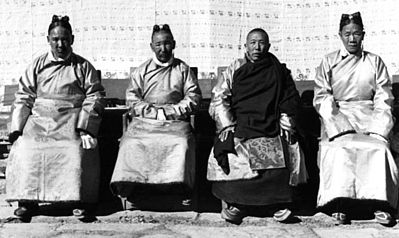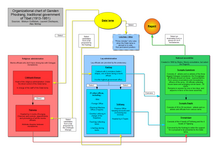Kashag

The Kashag (Tibetan: བཀའ་ཤག ་, Wylie: bkaʼ-shag, ZYPY: Gaxag, Lhasa dialect: [ˈkáɕaʔ]; Chinese: 噶廈; pinyin: Gáxià) was the governing council of Tibet during the rule of the Qing dynasty and post-Qing period until the 1950s. It was created in 1721,[1] and set by Qianlong Emperor in 1751 for the Ganden Phodrang in the 13-Article Ordinance for the More Effective Governing of Tibet. In that year the Tibetan government was reorganized after the riots in Lhasa of the previous year. The civil administration was represented by the Council (Kashag) after the post of Desi (or Regent; see: dual system of government) was abolished by the Qing imperial court. The Qing imperial court wanted the 7th Dalai Lama to hold both religious and administrative rule, while strengthening the position of the High Commissioners.[2][3][4][5]

As specified by the 13-Article Ordinance for the More Effective Governing of Tibet, Kashag was composed of three temporal officials and one monk official. Each of them held the title of Kalön (Tibetan: བཀའ་བློན་, Wylie: bkaʼ-blon, Lhasa dialect: [kálø ̃]; Chinese: 噶倫; pinyin: gálún), sought appointment from the Qing imperial court, and the Qing imperial court issued certificates of appointment.[2]
The function of the council was to decide government affairs collectively,[2] and present opinions to the office of the first minister. The first minister then presented these opinions to the Dalai Lama and, during the Qing Dynasty the Amban, for a final decision. The privilege of presenting recommendations for appointing executive officials, governors and district commissioners gave the Council much power.
In August 1929, the Supreme Court of the Central Government stated that before the publication of new laws, laws in history regarding Tibet, regarding reincarnation of rinpoches, lamas were applicable.[6]
On 28 March 1959, Zhou Enlai, the premier of the People's Republic of China (PRC), formally announced the dissolution of the Kashag.[7][8]
Ministries[edit]

Headed by the council was the government administration, divided into ministries: political, military, economic, judicial, foreign, financial and educational departments. Except for the Ministry of Finance (Tibetan: རྩིས་ཁང་, Wylie: rtsis-khang, Lhasa dialect: [tsíkaŋ]; Chinese: 商上; pinyin: shāngshàng), all ministries had two representatives – one temporal and one monastic. The Ministry of Finance had three lay officials. Each of them held the title of Tsipön (Tibetan: རྩིས་དཔོན་, Wylie: rtsis-dpon, Lhasa dialect: [tsípø ̃]; Chinese: 仔琫; pinyin: zīběng). All ministries had a right to make decisions to the extent of their competence. Matters, or problems outside the competence of ministries were (with a particular ministry's given opinion) presented to the council. Everything outside the competence of the council was presented to the Dalai Lama himself.
In Constitution of Tibet (10 March 1963 – 13 June 1991)[edit]
On 29 April 1959, the 14th Dalai Lama re-established the Kashag. In 1963, the 14th Dalai Lama promulgated Constitution of Tibet, and he became Head of State of Kashag of Tibet, all ministers of Kashag were appointed by the Dalai Lama.[9]
In the Charter of Tibetans in Exile (14 June 1991 – 14 March 2011)[edit]
In 1974, the 14th Dalai Lama rejected calls for Tibetan independence.[10] In 1991, the Charter of Tibetans in Exile was created, and the Dalai Lama became head of the Tibetan Administration and the executive functions for Tibetans-in-exile. Kashag was created and it consisted of Chief Kalon and seven Kalons.
In the Charter of Tibetans in Exile (29 May 2011 – present)[edit]
In March 2011, at 71 years of age, he decided not to assume any political and administrative authority, the Charter of Tibetans in Exile was updated immediately in May 2011, with Kashag consisting of Sikyong and no more than seven Kalons.
According to Michael Backman, notable past members of the Cabinet include Gyalo Thondup, the Dalai Lama's eldest brother, who served as Chairman of the Cabinet and as Kalon of Security, and Jetsun Pema, the Dalai Lama's younger sister, who served variously as Kalon of Health and of Education.[11] Article 12 of the 29-Article Ordinance for the More Effective Governing of Tibet states that relatives of the Dalai Lama or Panchen Lama must not hold government positions, or participate in political affairs.[12]
- Penpa Tsering – Sikyong
- Penpa Tsering – Acting Kalon for Home
- Penpa Tsering – Acting Kalon for Religion & Culture
- Norzin Dekyi – Kalon for Information & International Relations
- Kalon Tharlam Dolma Changra – Kalon for Education
- Dolma Gyari – Kalon for Security
- Penpa Tsering – Acting Kalon for Finance
- Penpa Tsering – Acting Kalon for Health
References[edit]
- ^ Dawa Norbu, China's Tibet Policy
- ^ a b c Jiawei Wang; Gyaincain Nyima; Jiawei Wang (1997). The Historical Status of China's Tibet. pp. 58–. ISBN 978-7-80113-304-5.
- ^ Seventh Dalai Lama Kelsang Gyatso Archived 2010-07-01 at the Wayback Machine
- ^ The Dalai Lamas of Tibet, p. 101. Thubten Samphel and Tendar. Roli & Janssen, New Delhi. (2004). ISBN 81-7436-085-9.
- ^ Tsepon W. D. Shakabpa, Tibet, a Political History (New Haven: Yale, 1967), 150.
- ^ "【边疆时空】喜饶尼玛 李双|国民政府管理藏传佛教活佛措施评析_蒙藏". www.sohu.com. Retrieved 2023-08-11.
- ^ https://sites.fas.harvard.edu/~hpcws/jcws.2006.8.3.pdf [bare URL PDF]
- ^ Jian, Chen (2006). "The Tibetan Rebellion of 1959 and China's Changing Relations with India and the Soviet Union". Journal of Cold War Studies. 8 (3): 54–101. doi:10.1162/jcws.2006.8.3.54. ISSN 1520-3972. JSTOR 26925942. S2CID 57566391.
- ^ 十四世达赖喇嘛. 五洲传播出版社. 1977. ISBN 9787801132987.
- ^ "The Dalai Lama Has Been the Face of Buddhism for 60 Years. China Wants to Change That". Time. 2019-03-07. Retrieved 2023-08-11.
- ^ Backman, Michael (2007-03-23). "Behind Dalai Lama's holy cloak". The Age. Retrieved 2010-11-20.
- ^ 達賴喇嘛和班禪額爾德尼周圍的隨從官員,過去都是他們的親屬,如達賴喇嘛的叔父和班禪額爾德尼的父親班丹團主,都是私人升任,又如達賴喇嘛之胞兄洛桑格登主巴,依仗勢力多行不法。今後應依西藏各階層及扎什倫布僧俗人民之願望,在達賴喇嘛和班禪額爾德尼在世時,其親屬人員不准參預政事。達賴、班禪圓寂後,如果還有親屬,可以根據他們的技能給予適當的職務。
